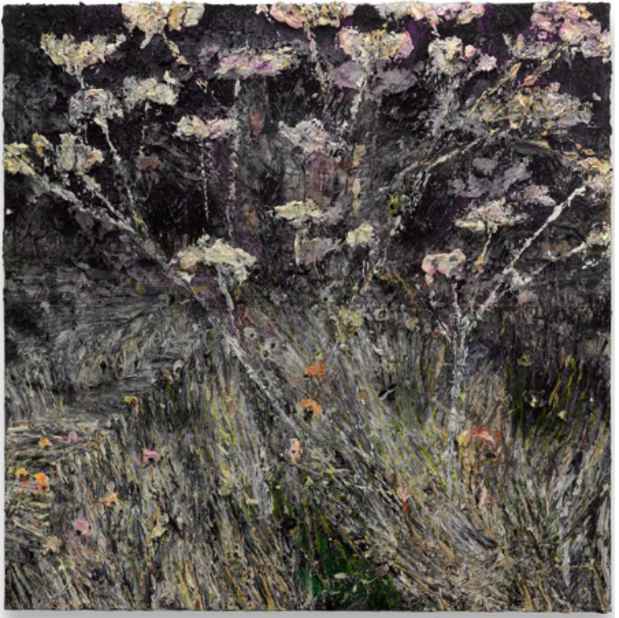Anselm Kiefer “Morgenthau Plan”
Gagosian Gallery 21st Street

This event has ended.
Beauty requires a counterpart. And in thinking about this flaw, the other flaw occurred to me as well: the Morgenthau Plan. For it too ignored the complexity of things.
—Anselm Kiefer
Gagosian Gallery presents an exhibition of recent paintings and sculpture by Anselm Kiefer, which further explores the historical and formal concerns of “Morgenthau Plan,” his exhibition that inaugurated Gagosian Le Bourget in Paris last October.
Born at the close of World War II, Kiefer reflects upon and critiques the dangerous myths that propelled the Third Reich to power. Fusing art and literature, painting and sculpture, the artist engages German history and the ancestral epics of life, death, and the cosmos to reinforce lessons of the past.
The exhibition at Le Bourget and the subsequent body of work on view in New York draw upon the Morgenthau Plan as an apt metaphor for a common pitfall of the creative process—namely, works that put forth beauty without any other detectable motive. Kiefer presents the shortsighted, wrong-minded initiative as a representation of ideas—artistic and political—that ignore “the complexity of things.”
Proposed in 1944 by former United States Treasury Secretary Henry Morgenthau, the plan was conceived to transform post-war Germany into a pre-industrial, agricultural nation, allegedly in order to limit the country’s ability to wage war. Morgenthau sought to divide Germany into two independent states, annexing or dismantling all German centers of industry in an arrangement that would have led to the death of millions by pestilence and starvation. Although the Morgenthau Plan was never realized in its original and most extreme form, it represented an alternative post-war Germany potentially occupied more by farmland and plant-life than industry. In his latest paintings, Kiefer explores the landscape of this double-sided initiative. Flowers—one of his central leitmotifs—bloom through the devastation.
Revisiting a process used earlier in his career, Kiefer paints directly onto color photographs of fields in bloom that he took near his property in southern France, then printed to fit canvases of various sizes. Der Morgenthau Plan depicts an area overgrown with flowers, rendered in thick impasto that completely obscures the original photograph. From top to bottom, the vast canvas dramatically transitions from light to dark, ending in a carpet of drab, black and green mulch. Morgenthau Plan: Laßt tausend Blumen Blühen / Let a thousand flowers bloom conflates the travesty of the German post-war plan with Mao Zedong’s shrewd co-optation of the idealistic classical Chinese maxim, “Let a hundred flowers bloom; let a hundred schools of thought contend,” designed to expose and flush out anti-Communist dissidents. Kiefer reflects on the misappropriation of this passage for autocratic purposes: amid pastel blossoms, black petals spring up above the rest into a muddled ochre landscape.
O Halme, ihr Halme, O Halme der Nacht, a huge dark canvas that transports the viewer to a desolate world by night, features an airplane wing that Kiefer fabricated from metal, jutting from its upper center. Like chalk on a blackboard, faded German cursive hovers in the night sky: ‘O Halme, ihr Halme, O Halme der Nacht’ (O Stalks, your stalks, O Stalks of the Night). In the barren landscape below, only a few stalks are blooming.
Anselm Kiefer was born in 1945 in Donaueschingen, Germany. After studying law, he began his art education in Karlsruhe and then Düsseldorf, where he studied informally under Joseph Beuys. His work has been shown and collected by major museums throughout the world. Recent retrospective surveys include “Anselm Kiefer: Heaven and Earth,” the Modern Art Museum, Fort Worth, Texas (2005, traveled to Musée d’art contemporain de Montréal, the Hirshhorn Museum and Sculpture Garden, Washington, D.C., and the San Francisco Museum of Modern Art) and “Anselm Kiefer,” Guggenheim Museum Bilbao (2007). In 2007, Kiefer inaugurated the “Monumenta” program at the Grand Palais, Paris with a vast site-specific installation of sculptures and paintings. In 2009, he directed and designed the sets for Am Anfang (In the Beginning) at the Opéra National de Paris.
Kiefer lives and works in France.
[Image: Anselm Kiefer “Morgenthau Plan” (2012) Photographic emulsion and acrylic on canvas, 149 5/8 x 149 5/8 in.]
Media
Schedule
from May 03, 2013 to June 08, 2013
Opening Reception on 2013-05-03 from 18:00 to 20:00